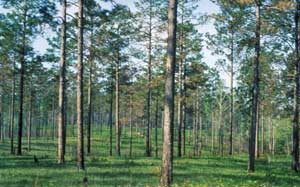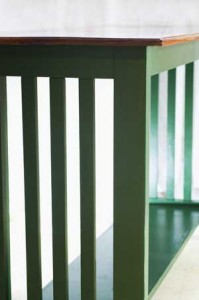
I know. The words cheap and good usually aren’t used together when the subject is wood for woodworking. But in the case of the Southern yellow pines, this wording is well-suited.
Southern yellow pine is a catchall phrase for all of the Southern pines. They include loblolly, shortleaf, slash, longleaf and Virginia, as well as some other minor species. They are commonly known as “softwoods” and are mostly sold as dimensional lumber for construction.
There are perhaps a couple of reasons many woodworkers are biased against the yellow pines for use in woodworking projects. Since the Southern yellow pines are known as “softwoods,” it is felt that they are not appropriate for furniture projects due to lack of strength and possible dents and dings they will inherit. A second reason is the notion that Southern yellow pine will shrink and swell much more than commonly used hardwoods. Lastly, and this part is true, it is very difficult to stain; it begs to be painted.
The term “softwoods,” as it is used for the Southern pines, doesn’t mean exactly what you think. This lumber is soft in that it is easy to saw and very easy to work,

but this has nothing to do with “hardness.” Hardness in lumber is usually rated on the Janka Hardness scale, which measures the relative force needed to drive a .444 inch steel ball into the wood to one half the depth of the ball. This has become the standard to determine if a wood is suitable for flooring and can also be used to compare woods used in cabinet making. The Janka hardness rating for most yellow pine is 690, whereas red oak is 1,290. With no other information, it appears pine is not useful. This would be a mistaken conclusion. Sure, it is much softer than oak, but check this out: the other woods commonly used for internal parts for furniture and cabinets are not as hard as pine. Examples are poplar at 540, American chestnut at 540 and Douglas fir at 660; longleaf pine is even harder than mahogany. So, based on hardness ratings, Southern yellow pine is a winner. It is cheaper, too. A quick check with my big-box store today revealed that a 1″ x 8″ board of yellow poplar is 30 percent higher than pine. Poplar was priced at $3.09 per linear foot, and the same size and quality of a board of yellow pine was $2.37. If you are painting it, you can find yellow pine in lower grades than yellow poplar at an even deeper discount. Compare that to red oak, which was more than twice the cost of yellow pine at the same store.
The second perceived problem is with shrinkage and swelling. All yellow pine on the market today is kiln dried. The problem is that once it is kiln dried, it is frequently stored outdoors and regains much of that moisture. To stabilize it, you need to bring it into your shop for a month or two for it to dry back out. Check it with a moisture meter, and when it is at the same moisture content as your hardwood, it is plenty stable.
So if you’re into saving money on your painted projects, try Southern yellow pine. It is strong, stiff, and fairly shock-resistant. About the only difference I have noticed between it and poplar is that the resins in pine tend to clog sandpaper faster. The pleasant smell of pine resin more than makes up for that in my book.
Tim Knight






